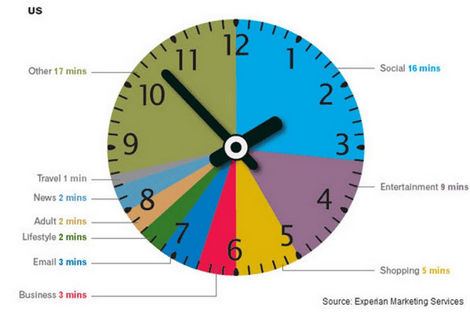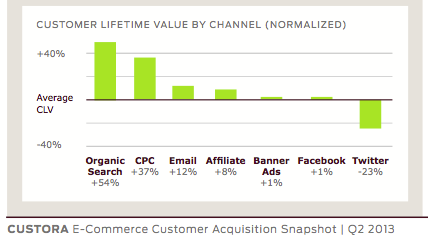3 Stats to Make You Second-Guess Social

If the Internet was a high school, social media would be the popular clique that every brand wants to be a part of.
Even though associating with sites like Facebook, Twitter and Pinterest definitely has its benefits, many Web professionals don't look past surface-level data - failing to correlate resources spent (time, money) to total return on investment (ROI).
A recent Shopify study, for example, shows that customers referred from Polyvore have the highest average order value at $66.75 (when compared to all other social networks), yet this social commerce community is not on most brands' radar.
Before you allocate more time and money to manage your brand's social efforts, look at three stats that could make you second-guess social (or, at the very least, some of your decisions):
Stat: For every hour spent online, Americans spend 16 minutes on social networks.
Experian Marketing's 2013 Digital Marketing Report reveals that the top online activity is social media, with Americans spending 16 minutes on social networking sites for every hour they are online. Comparatively, consumers spend an average of 9 minutes on entertainment sites, 5 minutes on ecommerce sites, and just 2 minutes on lifestyle and news sites.
Since the majority of brands use social media marketing as a way to direct consumers to owned Web properties (e.g. websites, blogs), this data is alarming. After all, getting someone to your website is the first step to conversion, while website engagement metrics like page views and time-on-site help brands (like information publishers) sell advertising.
Although abandoning your social presence is certainly not the answer, it is a good idea to measure how much traffic is being driven to your site from each individual network. By doing so, you can allocate resources better and make informed marketing decisions. Additionally, brands should link back to engaging content on owned Web properties in their social posts in order to increase site engagement metrics. Keep in mind, however, that posting too many social updates can actually backfire. In fact, Socialbakers found that daily Twitter engagement starts to decline after a brand's third tweet, which is why it is important for brands to post content that will enrich their audience rather than just put the company's name in the newsfeed.

Stat: 61% of SMBs see no ROI from social media activities.
Social media can be a huge time suck. A 2013 study from online business community Manta reveals that despite 49 percent of SMBs increasing the time they spent on social media, 61 percent claim that they saw no ROI from their social initiatives.
Although tracking the true ROI of social can be challenging (Demand Metric found 70 percent of companies are unable to show the ROI of their social efforts), it is eye-opening to see nearly half of Manta's studied SMBs putting resources into a channel that they either see no value in or don't know how to measure.
There are, of course, solutions brands can leverage to help them measure their social efforts better. Monitoring platform awe.sm, for instance, helps marketers visualize the conversion funnel by shortening, customizing and tracking the activity of the links a brand shares on social networks. Conversely, social analytics platform Curalate can also be used to measure social ROI, as it features pin-to-purchase tracking technology.

Stat: Customers acquired from Twitter have a 23% lower customer lifetime value (CLV).
The Ecommerce Customer Acquisition Snapshot released by lifecycle marketing company Custora reveals that Twitter is low on the virtual totem pole when it comes to the CLV of customers acquired through the social network.
The data found that the highest-value customers arrive through organic search, as these customers have a 54 percent higher CLV than average. Conversely, customers acquired through email have a 12 percent higher CLV, while Facebook customers have just a 1 percent higher lifetime value. Although the study notes that the short lifetime value associated with customers that come from Twitter could be attributed to the frequency of discounts offered within tweets, this is definitely a metric that brands need to pay attention to. In doing so, brands can decide to either reduce time spent in the social network that is providing customers with short lifetime values, or they can create an email marketing campaign that will nurture one-and-done customers until they become regular buyers.

Don't Sign Out Just Yet
Just because social may actually not be as cool as everyone thinks it is, having a presence on popular networks still provides benefits. Not only can social increase visibility for a brand, but it can also help businesses build authority and foster genuine relationships with their customers. It is important, however, to analyze the true business value each social network provides, before investing more time and money into this marketing channel.

Subscribe to Our Newsletter!
Latest in Social Media










